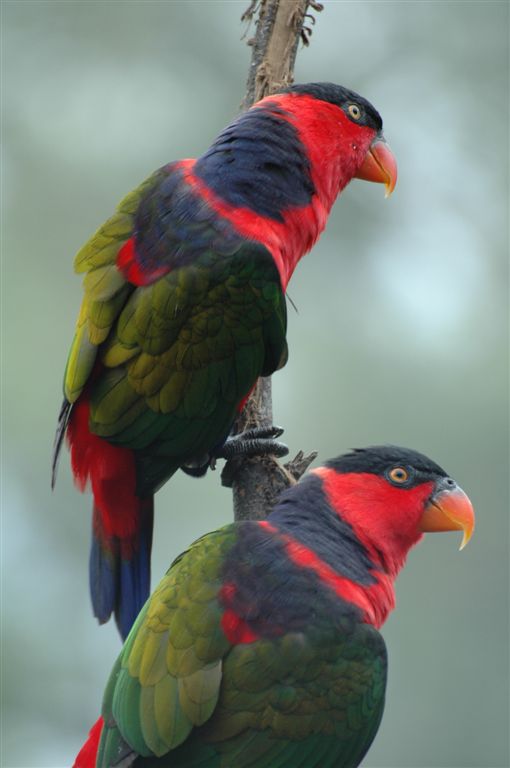- Black-capped Lory
Taxobox
status = LC | status_system = IUCN3.1
name = Black-capped Lory

image_width = 220px
caption = need picture
regnum =Animal ia
phylum = Chordata
classis = Aves
ordo =Psittaciformes
familia =Psittacidae
genus = "Lorius "
species = "L. lory"
binomial_authority = (Linnaeus, 1758)
binomial = "Lorius lory"The Black-capped Lory, "Lorius lory", also known as Western Black Capped Lory or the Tricolored Lory,is aparrot found fromJava throughNew Guinea . It is a colorful and relatively robust lory (31 cm). There are seven subspecies, all with green wings, red heads and body around the wing, a black cap, grey-black cere, yellow underwings, and blue legs and belly. Most also have a blue nape and mantle (area between wings on the back). The subspecies vary considerably in color:
* L. l. "Lory": West Papuan islands andBird's Head Peninsula . Blue of nape, mantle, and belly merge to cover most of body and are purple-blue. Red underwing coverts. Juvenile resembles "erythrothorax" or "cyanuchen".
* L. l. "erythrothorax": The whole south coast of New Guinea east of Bird's Head Peninsula, and the SE north coast. Blue nape almost forms collar, blue comes halfway up belly. Yellow on wings. Blue mantle in two bands. Red underwing coverts.
* L. l. "somu": Southern hill districts of central New Guinea. Red mantle and nape, blue only low on belly.
* L. l. "salvadorii": Northwest coast of Papua New Guinea. Like "erythrothorax" but with blue-black underwing coverts.
* L. l. "viridicrissalis": Northeast coast ofWestern New Guinea . Like "salvadorii" but blue blacker everywhere.
* L. l. "jobiensis":Yapen andMios Num islands. Like "salvadorii" but paler breast and mantle bands.
* L. l. "cyanuchen":Biak island. Black of cap meets blue of nape, single blue mantle stripe.Inhabits the primary forest and forest edges in most lowland areas up to 1000m (sporadically to 1750m), but not monsoon forest or coconut plantations. Usually found in pairs and occasionally in groups of 10 or more. Their diet includes pollen, nectar, flowers, fruit and insects. The "cyanuchen" subspecies is somewhat endangered, with fewer than 5000 individuals remaining.
Gallery
References
*"Parrots: A Guide to Parrots of the World"; 1998, ISBN 0-300-07453-0.
Wikimedia Foundation. 2010.
